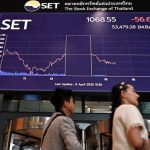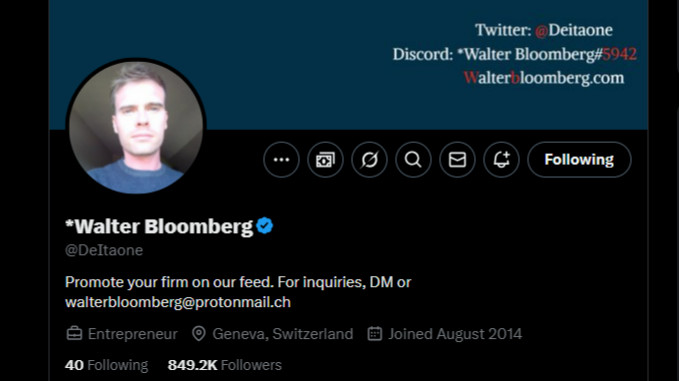Monday’s trading action was bizarre in many ways.
But one specific mystery — about a misleading headline that sent stocks ping-ponging all over the place — highlights just how fragmented and expensive access to breaking financial news can be, even at times when it really matters to retail investors.
The US stock market did indeed go bananas this morning, thanks to a headline that falsely* claimed White House adviser Kevin Hassett had said President Donald Trump was considering a 90-day pause in tariffs.
CNBC anchors read out the headline on air, as they tried to explain why markets had started to soar. In all, the S&P 500 rallied nearly 6 per cent from where it had been trading right before the mystery headline.
The White House said within the hour that no one knew about this supposed plan, a rare chance to properly use the term “Fake News”. Stocks sold off by the same amount they’d rallied, and then see-sawed around for a while. By mid-afternoon they were basically flat for the day.
So where exactly did the headline come from? That’s a much tougher question to answer than you’d think.
The obvious point of contagion was the Walter Bloomberg account, using the X handle @DeItaone (with a capital I instead of an “L”) which says it’s based in Switzerland.
This is not a guy named Walter Bloomberg, nor does he write for Bloomberg. The account’s entire deal is just reposting financial newswire headlines.
Here’s the post via a screengrab (since the account has since deleted the post). As you can see, it came at 10:13am, and really made the rounds within the next 30 minutes or so, thanks to the account’s ~848,000 followers:

By the way, all the times we’ll mention are EDT since the action happened during the New York trading day.
So did someone posting as “Walter Bloomberg” make up a headline to save the market? To cash out? Or just to introduce some chaos into the day?
If so, it’d be strange for the account to keep posting! But it has.
When asked by followers, the Walter Bloomberg account cited both Reuters and CNBC as the sources of the headline. Remember, though, the CNBC anchors seemed to be reading his post! One of his screengrabbed sources shows a Reuters newswire headline. But that was from 10:23am, and cites CNBC:
— *Walter Bloomberg (@DeItaone) April 7, 2025
Now, it’s not great if CNBC flashed a headline because one of their anchors read a social-media post that turned out to be nonsense. In their defence, however, markets had already started to take off before they read it!
But is the lesson here really just that the @DeItaone account has massive influence?
Probably not! Things get weirder from here.
An account called Hammer Capital posted the same headline at 10:11am. That’s before the post from Walter Bloomberg, or CNBC, or any other sources we’ve found. Hammer Capital, who has been on X since March 2021, explained the headline thusly:
To be as abundantly clear as possible, trading desks started sending out this headline at 10:09.
I was regurgitating what the market was reacting to, to my 600 followers.
It was an incorrect interpretation of a Fox News interview. https://t.co/RpN6c5RqfW
— Hammer Capital (@yourfavorito) April 7, 2025
We’ve heard from few other sources now that trading desks started sending around that headline around at that time. We’ve contacted both accounts we’ve mentioned for additional comment.
Also, looking at the not-so-sophisticated trading data this writer has available at home, S&P 500 futures trading volume surged around then, before the Walter Bloomberg or Hammer Capital tweets were posted.
So . . . where did the banks get the headline?
As we said, the “Walter Bloomberg” account basically just copies financial breaking-news headlines from newswires. And the thing is, those wires often come with an extremely pricey subscription. If Hassett had done an exclusive interview about major US policy decisions — and he did not, probably* — only a major financial news service would’ve been able get that exclusive access.
The newswires don’t just offer one uniform news feed, either. While we aren’t 100% up to speed on the latest business models, some newswires have been known to deliver news feeds to different subscribers at different speeds. This is reasonable, to an extent, because not all professional subscribers can use the same level of access.
So it seems possible that some experimental headline-writing product (or a budget subscription) published a bad headline that was then picked up by the Walter Bloomberg account.
There’s one less-than-obvious analogue with reality, which could have been misinterpreted by an overzealous headline writer or (ahem) an LLM. In a Fox & Friends interview, National Economic Council director Kevin Hassett stalled by saying “yep” before saying “the President is going to decide what the President is going to decide.”
This was obviously not confirmation, because he then argued that observers are overreacting to the tariffs news.
Another problem with that explanation is that the interview happened nearly two hours before @DeItaone published the headline. And Hassett’s ‘Fox & Friends’ comments wouldn’t have explained the part about an exception for China. Reuters provided the following comment to FT Alphaville:
Reuters, drawing from a headline on CNBC, published a story on April 7 saying White House economic adviser Kevin Hassett had said that President Donald Trump was considering a 90-day tariff pause on all countries except China. The White House denied the report. Reuters has withdrawn the incorrect report and regrets its error.
So they’re pointing the finger at CNBC. But again, the network’s anchors seemed as confused as anyone else by the rally and the accompanying surge in trading volume when it first happened. (We’ve seen the video!)
And from CNBC:
As we were chasing the news of the market moves in real-time, we aired unconfirmed information in a banner. Our reporters quickly made a correction on air.
We’ll see what we can find out about where banks’ trading desks and broker chats saw the original headline.
Anyway, the market zigzagged all over the place after the morning ruckus, and closed basically flat. That’s presumably because some traders think the US President can be swayed by market reactions to fake news.
Or, as the @Quantian account puts it:
So we bounced 8% on a fake headline, sold off when people realized it was fake, and then bounced again when it occurred to people that if we bounced that much on a fake headline imagine how much we’d bounce on a hypothetical real one.
*The original headline’s accuracy could, of course, change entirely at any moment, at the whims of one man. How fun! Also an earlier version of this headline said Twitter instead of X. Whoops.
Read the full article here













